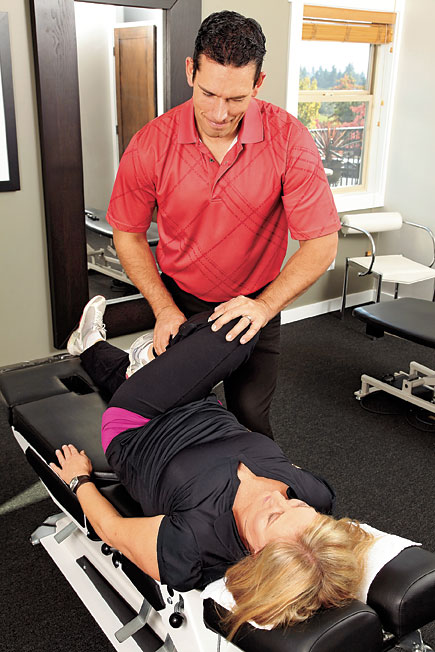Hands-On Healing—Many look to chiropractic care for relief
By Karen Dix
March 2012 View more Health & Fitness
 Naperville chiropractor Dr. Richard Whitney of Whitney Chiropractic Center once suffered from chronic stomach problems, but conventional medication failed to relieve his discomfort. Then a friend recommended a chiropractor; a simple spinal adjustment finally relieved Dr. Whitney’s condition, and led the former veterinarian into a new, satisfying career.
Naperville chiropractor Dr. Richard Whitney of Whitney Chiropractic Center once suffered from chronic stomach problems, but conventional medication failed to relieve his discomfort. Then a friend recommended a chiropractor; a simple spinal adjustment finally relieved Dr. Whitney’s condition, and led the former veterinarian into a new, satisfying career.
The Art of Chiropractic
According to the American Chiropractic Association, chiropractic focuses on “disorders of the musculoskeletal system and the nervous system, and the effects of these disorders on general health.” While people typically seek the services of a chiropractor for relief of back and spine pain, the scope of services for the Doctor of Chiropractic is much more broad, including therapeutic and rehabilitative exercises, and nutritional, dietary, and lifestyle counseling.
Chiropractic primarily deals with the identification and correction of “vertebral sublaxations,” or misalignments of the vertabrae that can be caused by many things, including trauma, lifestyle conditions, or poor nutrition. Sublaxations stress the nervous system, causing a variety of unpleasant physical conditions in the muscles and tissues of the body. Chiropractors often correct sublaxations with a manual spinal adjustment, to realign the vertebrae and restore the nervous system to normalcy. For patients, the effects can be dramatic on a number of elusive ailments, from chronic back pain to migraine headaches, allergies, and stomach ailments.
“People who come in have exhusted all other medical options and are looking for a resolution to their problem,” said Dr. Whitney. He says he educates patients on the 80-10-10 rule: With chiropractic treatment, 80 percent of patients will get better, 10 percent will improve, and 10 percent will need treatment outside the scope of the practice.
Embracing the Alternative
A visit to a chiropractor may resemble a doctor’s visit, with typical tests such as urinalysis and x-rays. Chiropractors work in concert with traditional medicine, giving and receiving referrals and medical test results, but their main healing methods vary. Physicians rely heavily on prescription medication, while the chiropractor looks for ways to empower the body to heal itself, taking into account a patient’s lifestyle and nutritional choices.
Dr. Richard Merrion from the Illinois Wellness Group explains that a patient’s symptoms are the last thing to show up and the first thing to be relieved upon treatment, but the overall health of the patient needs to be considered to truly heal the patient. “Absence of disease doesn’t mean you’re healthy,” he says. “We educate people about wellness, not just avoiding sickness.”
When a spinal adjustment is warranted, Dr. Merrion assures patients “there’s typically no pain if they’re done properly. If a patient is already in pain, we will do everything we can to relieve it,” he says.
Dr. Kent Christianson, a chiropractor and digestive specialist at Holistic Chiropractic and Healing Arts Center, emphasizes that a person’s stress level affects organ function because embryologically, our internal organs share the same nerves as our muscles do. “When we know our muscles we can ascertain stressed organ function,” he says. He often wears the hat of the “stress specialist” for his patients. “Our goal is to remove interferences so the body can heal itself, through diet therapy, nutrition, detoxes, or acupuncture and shiatsu,” he says. Shiatsu, or “finger pressure” massage, as well as acupuncture, are just some of the ancient Chinese stress relieving techniques available at his office.
Naperville chiropractors agree that as people learn more about chiropractic, they are embracing its possibilities. “More patients are starting to come in on their own,” says Dr. Merrion, “and they’re learning that chiropractic is about more than fixing back pain; it’s about addressing the root cause of their physical problem.”


